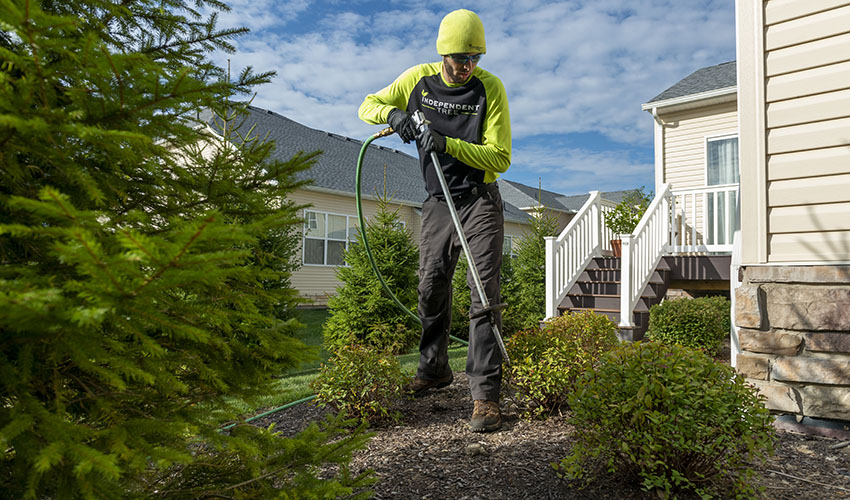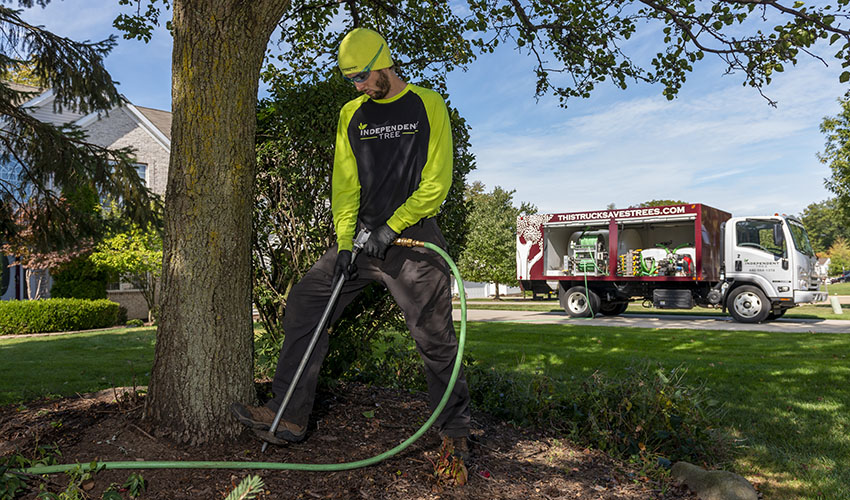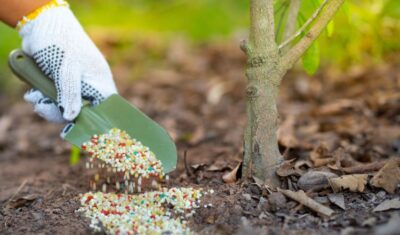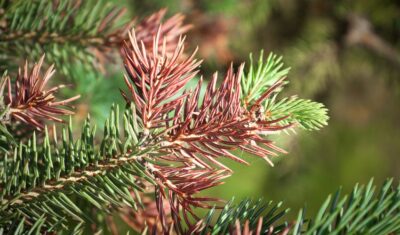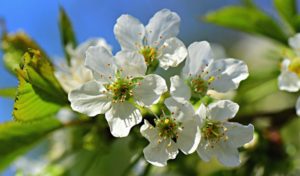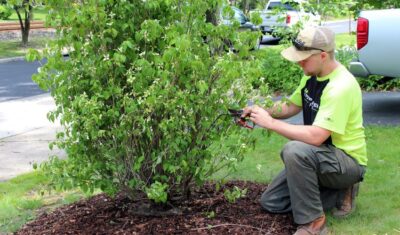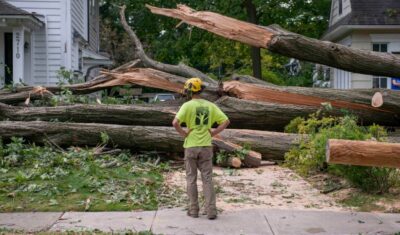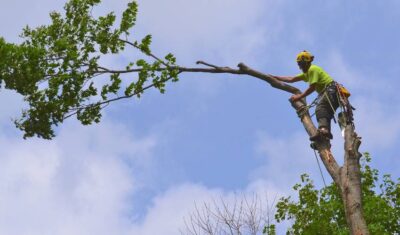All landscape plants need a steady supply of nutrients to grow and stay healthy. Many of our urban soils are lacking in minerals or nutrients (learn more about why and how to create healthy soils), leading to nutrient deficiencies in trees, shrubs, and other plants. Fertilization can help to improve the plant’s growing conditions and provide the ingredients needed for continued growth. But what’s the best way to fertilize trees and shrubs in Northeast Ohio? Keep reading to find out!
What is fertilizer?
A fertilizer is any material (of natural or synthetic origin) that is applied to soil or to plant tissues to supply plant nutrients.
Fertilizers come in many different forms, including pellets, granules, powders, liquids (and liquid concentrates), and more.
>> For more details, see our article on Tree & Shrub Fertilization FAQs: What, Why, When & How
How is fertilizer applied to landscape plants?
Depending on the form of fertilizer, it can be:
- sprinkled or scattered on the soil surface (this is the typical DIY method and is often used to fertilize lawns)
- mixed into the soil
- sprayed onto the soil
- placed in holes or trenches around landscape plants
- injected into the ground
- sprayed on the leaves, branches, or trunk
The key is to get the nutrients to plants’ roots where they can be absorbed (along with water) and spread throughout the plant.
What is deep root fertilization?
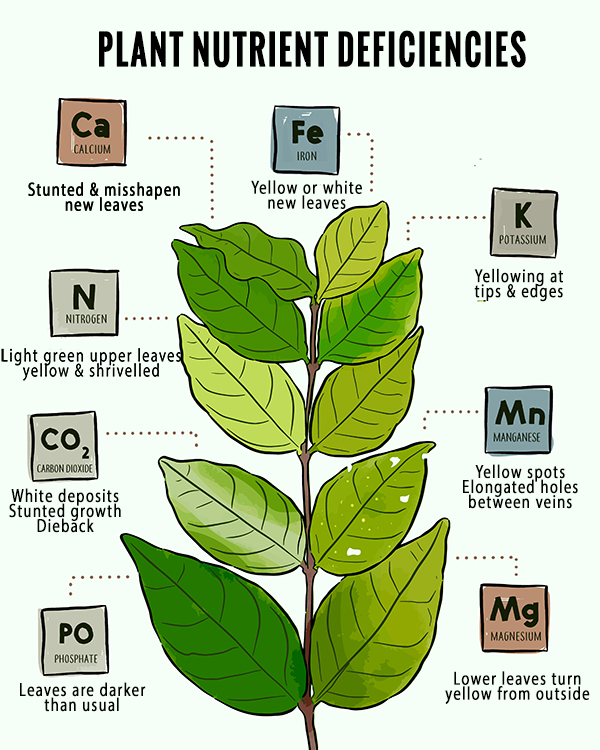
Deep root fertilization is a specialized type of fertilizer application method used to help restore trees that are struggling or showing signs of decline.
This treatment uses high-pressure professional equipment to inject a blend of nutrients and organic matter into the soil around your trees’ roots.
The liquid fertilizer is injected to a depth of roughly 5 inches (this is where most of a tree’s feeder roots are found). To ensure that all parts of the root zone receive enough nutrients, we usually inject in a grid pattern throughout the entire area under the tree canopy (out to the dripline, or canopy edge) and sometimes even beyond that depending on the tree species, health, and surrounding landscape.
Is deep root fertilization better than a DIY approach?
You may believe that you can fertilize your own trees, and we know many homeowners and landscapers do this. However, a basic granular fertilizer that you spread around the base of your tree simply will not have the long-lasting effects of a deep root fertilization treatment that is applied by a certified tree care expert.
Basic fertilizers are usually applied to the soil surface and then “watered in” using irrigation (or waiting for rainfall). Depending on what is growing around your trees, these surface-applied fertilizers may not penetrate the soil down to the tree’s root system. For example, lawn grasses often absorb most of the nutrients before the fertilizer-rich water percolates down to the tree’s root zone.
Plus, granular fertilizers can be easily washed away by rain or wind, rendering them ineffective and causing run-off problems in streams, rivers, lakes, and even wells.
In contrast, deep root fertilization puts the nutrients right where the tree needs them (in the root zone) and in a format that’s much more easily absorbed by the tree. As a result, you’ll see faster and more noticeable results.
Do your trees need a deep root fertilization treatment?
Any tree or shrub that appears to be struggling is a good candidate for a deep root fertilization treatment.
Signs of a struggling tree or shrub include:
- Defoliation – the tree is losing its leaves
- Slow or minimal growth
- Smaller and fewer leaves than usual
- Leaves dropping or changing their color too early, often appearing “scorched” or showing a yellow-brown color
- Discolored leaves, such as yellowing or pale leaves (often caused by chlorosis)
- General dieback in the tree canopy – leaves, twigs, and branches, usually at the top of the tree, begin to die and drop
What are the benefits of deep root fertilization treatment for trees and shrubs?
To start, this kind of fertilization restores essential nutrients that have been lost during the summer season. This allows the tree to absorb and store nutrients for the upcoming winter, increasing the chances of survival.
Because nutrients are applied throughout the root zone, rather than on the soil surface, deep root fertilization greatly decreases the risk of fertilizer runoff. Over-fertilization and associated runoff is a serious problem in Northeast Ohio so anything we can do to reduce that is a good thing!
Deep root fertilization also combats one of the primary stresses of many urban trees: soil compaction. Soil compaction usually occurs from a high volume of traffic, construction, or paved areas around or near the tree. It results in an inability of the tree to retain water and a low level of nutrients in the soil. By injecting nutrients and organic matter directly into the root zone, this kind of fertilization helps to loosen the soil and give the tree roots room to move. When tree roots cannot move, they are unable to grow or feed.
Deep root fertilization also improves soil aeration, letting the tree more easily absorb essential nutrients, water, and oxygen—everything the tree needs to survive!
To learn more about how organic fertilization helps your plants, as well as the soil, check out these blog posts:
- Is Your Soil Healthy? How to Tell & Why it Matters
- Benefits of organic spring fertilization
- Fertilization FAQs: What, what, why & how
When should this kind of fertilization be done?
Although deep root fertilization treatments can be applied in spring and summer, they’re more typically done in early fall. This gives the tree time to absorb the necessary nutrients before winter arrives and while the tree isn’t stressed by excessive heat, lack of moisture, and active growth.
Just one deep root fertilizer treatment will provide significant, long-lasting results for your trees.
We Can Help
If any of your trees don't look as healthy as they should, call Independent Tree for an inspection. Our arborists can diagnose the problem and determine whether deep root fertilization would be a good option to help improve the health and appearance of your tree.Recent Articles
Topics
About The Author

STAY IN THE LOOP
WITH OUR
LATEST UPDATES
"*" indicates required fields

